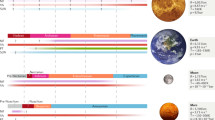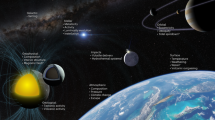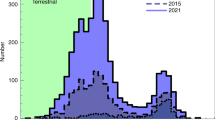Abstract
Venus is Earth’s near twin in mass and radius, and our nearest planetary neighbour, yet conditions there are very different in many respects. Its atmosphere, mostly composed of carbon dioxide, has a surface temperature and pressure far higher than those of Earth. Only traces of water are found, although it is likely that there was much more present in the past, possibly forming Earth-like oceans. Here we discuss how the first year of observations by Venus Express brings into focus the evolutionary paths by which the climates of two similar planets diverged from common beginnings to such extremes. These include a CO2-driven greenhouse effect, erosion of the atmosphere by solar particles and radiation, surface–atmosphere interactions, and atmospheric circulation regimes defined by differing planetary rotation rates.
This is a preview of subscription content, access via your institution
Access options
Subscribe to this journal
Receive 51 print issues and online access
$199.00 per year
only $3.90 per issue
Buy this article
- Purchase on Springer Link
- Instant access to full article PDF
Prices may be subject to local taxes which are calculated during checkout




Similar content being viewed by others
References
Taylor, F. W. Venus before Venus Express. Planet. Space Sci. 54, 1249–1262 (2006)
Svedhem, H. et al. Venus Express—The first European mission to Venus. Planet. Space Sci. 55, 1636–1652 (2007)
Titov, D. V. et al. Venus Express science planning. Planet. Space Sci. 54, 1279–1297 (2006)
Baines, K. H. et al. To the depths of Venus: Exploring the deep atmosphere and surface of our sister world with Venus Express. Planet. Space Sci. 54, 1263–1278 (2006)
Markiewicz, W. J. et al. Morphology and dynamics of the upper cloud layer of Venus. Nature doi: 10.1038/nature06320 (this issue).
Piccioni, G. et al. South polar features on Venus similar to those near the north pole. Nature doi: 10.1038/nature06209 (this issue).
Drossart, P. et al. A dynamic upper atmosphere of Venus as revealed by VIRTIS on Venus Express. Nature doi: 10.1038/nature06140 (this issue).
Bertaux, J.-L. et al. A warm layer in Venus’ cryosphere and high-altitude measurements of HF, HCl, H2O and HDO. Nature doi: 10.1038/nature05974 (this issue).
Gierasch, P. et al. in Venus-II (eds Bougher, S. W., Hunten, D. M. & Phillips, R. J.) 459–500 (Univ. of Arizona Press, Tucson, 1997)
Peralta, J., Hueso, R. & Sánchez-Lavega, A. A reanalysis of Venus winds at two cloud levels from Galileo SSI images. Icarus 190, 469–477 (2007)
Barabash, S. et al. The loss of ions from Venus through the plasma wake. Nature doi: 10.1038/nature06434 (this issue).
Zhang, T. et al. Little or no solar wind enters Venus’ atmosphere at solar minimum. Nature doi: 10.1038/nature06026 (this issue).
Pätzold, M. et al. The structure of Venus’ middle atmosphere and ionosphere. Nature doi: 10.1038/nature06239 (this issue).
Donahue, T. M., Grinspoon, D. H., Hartle, R. E. & Hodges, R. R. (eds Bougher, S. W., Hunten, D. M. & Phillips, R. J.) 385–414 (Univ. of Arizona Press, Tucson, 1997)
Russell, C. T. et al. Lightning on Venus inferred from whistler-mode waves in the ionosphere. Nature doi: 10.1038/nature05930 (this issue).
Author information
Authors and Affiliations
Corresponding author
Rights and permissions
About this article
Cite this article
Svedhem, H., Titov, D., Taylor, F. et al. Venus as a more Earth-like planet. Nature 450, 629–632 (2007). https://doi.org/10.1038/nature06432
Published:
Issue Date:
DOI: https://doi.org/10.1038/nature06432
This article is cited by
-
Venus, the Planet: Introduction to the Evolution of Earth’s Sister Planet
Space Science Reviews (2023)
-
How the Geomagnetic Field Influences Life on Earth – An Integrated Approach to Geomagnetobiology
Origins of Life and Evolution of Biospheres (2021)
-
Possible Atmospheric Diversity of Low Mass Exoplanets – Some Central Aspects
Space Science Reviews (2020)
-
Venus: The Atmosphere, Climate, Surface, Interior and Near-Space Environment of an Earth-Like Planet
Space Science Reviews (2018)
-
Returnability as a criterion of disequilibrium in atmospheric reactions networks
Journal of Mathematical Chemistry (2012)
Comments
By submitting a comment you agree to abide by our Terms and Community Guidelines. If you find something abusive or that does not comply with our terms or guidelines please flag it as inappropriate.



